In the twentieth century, Americans in particular seemed to have picked up a bug for defining themselves by the technologies they used. We are always apparently living in an “Age” of something. In and of itself, defining your own “Age” while you are living in it isn’t brand new — there was that whole “Age of Enlightenment” thing, of course — but our amazement at the apparently changed pace of life brought on by science and technology has sped this up quite a bit once things really got hopping in the last century.
Starting in August 1945, we officially began living in the “Atomic Age.” Which is to say, really, that people started saying that they were living the atomic age. We did this for awhile, and at some point transitioned to the “Nuclear Age,” the “Jet Age,” the “Space Age,” and so on.
A nice set of historical questions follow: When did those transitions between “Ages” happen? Which “Ages” were more influential, as a term of self-identification? Do “Ages” die, or just fade away?
Google’s Ngram Viewer makes this sort of thing quite fun to track, though the results aren’t necessarily straightforward. Basically the Ngram Viewer can track the usage of specific (case-sensitive) phrases across the Google Books corpus over time, normalizing them to a relative frequency of use (so that the results just don’t reflect how many books there were being published at any given time). It’s a nice way to get preliminary information about linguistic disputes, though it has plenty of obvious methodological difficulties.1
A wonderful case study: when did “atomic” lose traction to “nuclear“? Google NGrams gives a fairly unambiguous, mostly straightforward result:
In the beginning (1945), “atomic” was king. In 1958 or so, it was surpassed by “nuclear.” This coincides nicely with the startup of the first nuclear power plant in the United States, the Shippingport Atomic Power Station. It’s hard not to conclude that the shift from “atomic” to “nuclear” was caused by the growth of the nuclear power industry (even if Shippingport was itself under “atomic power”).
While “atomic” was on a free-fall from then on, “nuclear” enjoyed two peaks: on in the mid-1960s, then one in the mid-1980s. This maps fairly well onto the cultural history of nuclear weapons in the United States.2 With only a slight understanding of nuclear history, the 1960s (Cuban Missile Crisis, ICBMs, Limited Test Ban Treaty, Non-Proliferation Treaty) and the 1980s (Reagan, Gorbachev, Pershing Missiles, Reykjavik, “Star Wars,” Chernobyl) conjure up periods of high cultural interest in many things nuclear.
Interesting side-note: we all know that scientists and other precise-minded people consider “atomic” to be an inferior designation than “nuclear.” The energy we care about is not “atomic” in nature (which also includes the electrons) — it’s specifically involved in the fissioning or fusing of nuclei. And yet, “atomic” was what was even plastered across the official government statements in 1945 — the Smyth Report was originally meant to be titled “Atomic Bombs,” as I discussed on Wednesday. An interesting wrinkle is that Smyth himself hated the use of the term “atomic” when “nuclear” was meant, but was overruled by Groves and others. “Nuclear” just wasn’t a word well-known by the general public in 1945, whereas “atomic” has been common currency for a long time.
During the Manhattan Project, the scientists at the University of Chicago thought that they ought to use a completely new term to describe what they were doing:
We propose to use the word “nucleonics” as a name for this field. Reflecting the modern trend toward close correlation between science and industry, and following the load of “electronics”, we propose that the word “nucleonics” shall refer to both science and industry in the nuclear field.3
“Nucleonics” didn’t really take off, though. It was occasionally used by scientists, and there was a journal with the title, but in the public mind it never had any traction.
Returning to our question about the “Ages,” I ran a whole bunch of “age” phrases through the Ngram viewer. Here are the interesting results, methodological caveats notwithstanding:4
An interesting conclusion: We no longer live in the “nuclear age.” Which is to say, we no longer define our times by the fact of our using nuclear technology — which we still do, in abundance. (The United States still has well over 100 operating commercial nuclear reactors, providing around 20% of the nation’s electricity generation. The world still has thousands of nuclear weapons in it. Nuclear issues still appear on the front pages of newspapers with alarming regularity.) But since the mid-1990s, “information” has defined us overwhelmingly.
Methodological issues with these kind of keyword searches aside, these results jibe with the general feeling that our having specifically “nuclear” technology is not longer a distinguishing — or at least novel — characteristic of the times in which we live, in the same way that calling attention to the engines in our airplanes, or places we visited on a handful of occasions (outer space), soon ceased to be definitional of our times.
There’s an easy narrative one can make about this — perhaps too easy. New, disruptive technologies enter into our world. They seem to change everything. Machines completely changed the way labor worked and the nature of manufactured goods. The atomic bomb seemed to change everything about security, diplomacy, and war. The jet suddenly made distances very small indeed. Nuclear power and nuclear weapons became a mainstay of modern life. And information gradually began more and more to define how we operated in the world.
And yet, not one of these technologies replaced the others. We still have machines. We still have jets. We still have nuclear weapons and nuclear plants. But all of the others have long since ceased to impress us. Information still impresses us — we’re still in the middle of its thrall, we’re still shocked and surprised by the things it does for better and worse. So even though the information age feels a little old hat at this point, as a phrase, it’s still going strong in the zeitgeist. Until the next revolution.
But lest we feel that Information is something terribly new and shocking, take a look at that graph again: none of these, even the Information Age, hold a candle to how people talked about living in the Machine Age. One might be tempted, were one to take a long view of things, to say that the twentienth century was bracketed on one side by Machines, and on the other by Information. In between, we flirted with the Bomb.
- Transcription fidelity and dating fidelity are two major systemic issues with the Google Books corpus; the inability to tell what sense a given word is being used is an issue with any kind of “dumb” concordance approach. [↩]
- I haven’t separated out “American English” from “British English” on these charts, though Ngrams lets you do it. Frankly, I just don’t trust the results — I don’t know how it is claiming to tell one from the other, and I fear it has to do with publisher location, which is very misleading. In this particular graph, though, there are some interesting differences in the “British English” version from the “English” and “American English” versions, which are basically the same. Specifically, the rise of “nuclear” occurs slightly later, and slower in “British English,” and has a much more impressive peak around 1985. [↩]
- Z. Jeffries, Enrico Fermi; James Franck, T.R. Hogness, R.S. Mulliken, R.S. Stone, C.A. Thomas, “Prospectus on Nucleonics,” (18 November 1944), Bush-Conant File Relating the Development of the Atomic Bomb, 1940-1945, Records of the Office of Scientific Research and Development, RG 227, microfilm publication M1392, National Archives and Records Administration, Washington, D.C., n.d. (ca. 1990), Roll 3, Target 4, Folder 17, “S-1 Technical Reports (1942-44).” [↩]
- In all cases except Information Age, lower-case capitalization increased prevalence. One might suspect that indicates weird false-positives, but a perusing of the data shows that indeed, people did refer to, say, the “machine age” in lower case: “With the coming of the machine age” … “For the sake of the argument, it may be conceded that the machine age has produced nothing comparable with the best of the painting, sculpture, and architecture of antiquity and the middle ages” … “Further, if we are to preserve our adolescents from the banal mechanizing of a machine age”… and so on. “Motor Age,” “Plastic Age,” anything related to biological sciences don’t really chart compared to the others. “Sex Age” goes about as much as “jet age” albeit a decade later, but sex isn’t exactly a technology, so I’ve left it off. And the biggest difficulty here, of course, is the fact that you can’t tell from word counts whether people are self-identifying — thus a search for “Industrial Revolution” tells you little about how people called themselves at that point, given that the phrase takes off pretty much after the Revolution in question as a way of talking about the period itself. Ditto “Middle Ages,” “Age of Exploration,” and other such phrases which are descriptive of past times rather than present times. Additionally, it should be noted that the dataset only goes through 2008. [↩]
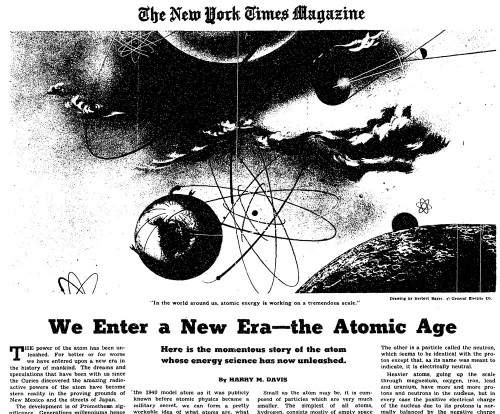
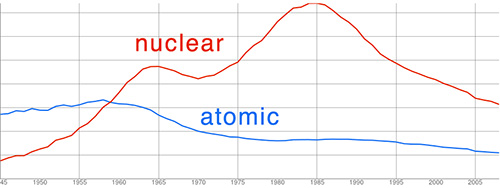
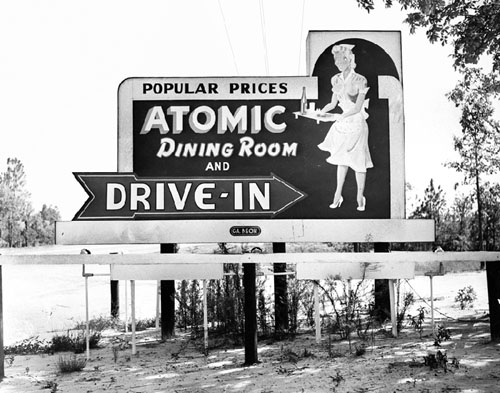
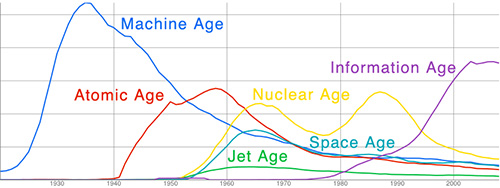



Another reader passes on the insight that you can disentangle the relative weights of “atomic” and “nuclear” things quite well with the Ngrams Viewer — “atomic energy” eclipses “atomic bomb” in the late 1950s, “nuclear weapons” is responsible for much of the “nuclear” peak, with the exception of the late-1970s and mid-1980s when the nuclear power debate was really heating up. Graphed:
Even more interesting. I think there was a bit of “re-branding” going on here. Have a defective product? No need to essentially change it, just give it a new name….
I’m sure that wasn’t the only thing at work, given academia’s interest in using correct terminology. But there is something to it. Ike even asked an old buddy of his who had a certain expertise in marketing, the CEO of Coca-Cola, about how he should sell atomic energy to the world. Let’s put it this way, nukes never had the crowd-pleasing appeal of Coca-Cola (which does rot your teeth, but not your genes.)
Not sure these images will work here, but here’s my example of where things started rather happily for “atomic” before they went bad with fallout. A much smaller outfit than Coca-Cola, The TomBoy Co., Indianapolis, IN rather unfortunately invested a new slogan around 1948 and immortalized it on the usual recyclable packaging of the day.
Here’s the front of the bottle:
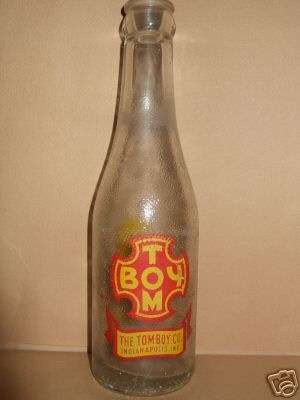
And the back, with Tomboy’s cheerful mascot reminding consumers of one of this marvelous product’s great features: It’s Atomic!
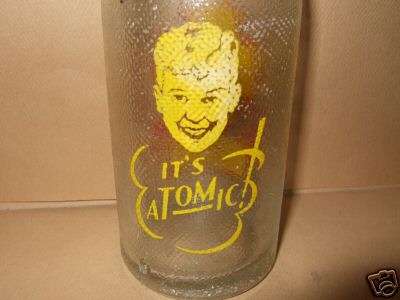
Within a very few years, moms were rethinking the idea of a product that included atomic ingredients, even those that didn’t advertise themselves as including it.
There was also the correlation between the rather dead-end idea of “clean” weapon designs and the upward trajectory of “nuclear.” Note that this was an influence near the end of the 1950s, as the fallout debate rose to a crescendo.
Because, after all, “Maude, aren’t them nuclear bombs the clean ones?”
“Yep, Pa, not like them dirty ol’ atomic ones we used to use.”
What’s funny is that today, you probably could get away with an “atomic” cola — on the retro factor alone.
(Sorry that comment took a few days to go up — my spam filter can be unpredictably aggressive at times, even though you’ve had many previously approved posts.)
Alex,
No problem, the filter did good. I was posting from my new laptop for the first time — the one that doesn’t have 0% disc space left…
Atomic has certainly been rehabilitated. In fact, It’s a huge category on that popular auction site. Makes it kind of hard to find the gems, like the bottle above, when sorting among all the items that atomic seems to help sell these days.
Nuclear seems to have a far more negative connotation, but that’s the current context at work. People worry when you say someone is “about to go nuclear” on something. Tell them you’re about ready to”go atomic” and they will more likely smile knowingly about your amusing retro language.
Indeed, I just stumbled across “Atomic Ranch” magazine (http://www.atomic-ranch.com/about/about.php) which “celebrates midcentury houses—from 1940s ranch tracts to 1960s architect-designed modernist homes. With an emphasis on affordable solutions and homeowner renovations, our quarterly magazine shows you how to make your house cool, both inside and out.”
Amusingly, I found it at my local Whole Foods while looking for “American Bungalow” which does the same thing for “to homes of the early 20th century, the philosophy of the Arts and Crafts movement and the bungalow lifestyle.” Before all this atomic nonsense got going…
Shouldn’t “hydrogen bomb” be added into that mix too to fill in the gap in the 1950s when “atomic bomb” was becoming less popular and the public got to hear about the new “superbomb”. I would suspect it should have a big bump in the Fifties given the public interest then declining as nuclear weapons too over.
However it turns out that “hydrogen bomb” only a steady ramp in the Fifties and by 1960 it’s on the downturn. That it never exceeds “atomic bomb” or “atomic weapons” or “nuclear weapons” really suprises me and may be an interesting insight into how the public perceived this weapon.
BTW, “superbomb” hardly gets off the origin: poor old Teller he never really had the knack for naming things.
“Up and atom” (as the Radioactive Man parodies on The Simpsons said)
What’s always been interesting to me about the hydrogen bomb (I have fantasies of writing an entire book on the H-bomb someday) is the way it is at first delineated as something different than the atomic bomb (during the debate about it and during the early years of the megaton age), but it very quickly gets folded into the broader rubric of “nuclear weapons”, to the point where today it’s hard to make people understand why folks like Fermi, Rabi, and Oppenheimer thought it was qualitatively different than regular fission weapons. To put it another way, I’ve had difficulty explaining to undergraduates why people in the 1950s thought that the line to be crossed was between atomic and hydrogen weapons — that the specific design of the weapon entitled a different moral or political order.
That reminds me: Last year, after the Fukushima accident, I wrote about the history and changing meanings of “meltdown.”
That’s interesting, Bill. What did they call meltdowns before EBR-1?
I don’t know enough history to answer that question.
I think the term meltdown as it applies to nuclear energy probably has it’s origins with the work of Samuel Untermyer. I’m not sure if he coined the term but he conducted a series of reactor tests in the 1950’s at the INEEL BORAX I test reactor Untermyer wanted to determine whether BWR’s could survive steam bubble formation in the core this was done through a series of power excursion tests. In July of 1954 a power excursion was deliberately used to destroy the reactor it was expected that a minor fraction of the fuel would melt but it was found that a large portion of the fuel had melted this had major ramifications for future reactor fuel development. They now knew a BWR design could be pushed pretty hard but if it was pushed too far it could have unexpected results. About a year later EBR-1 (different design) exhibited fuel melting too this spawned more reactor safety tests but it didn’t stop the commercialization of the EBR-1 design as the later failed Fermi-1 of “We Almost Lost Detroit” fame.
http://neutron.kth.se/courses/reactor_physics/LectureNotes/BORAX1.pdf
The BORAX 1 final test and the EBR-1 accident were followed by the SPERT series of purposeful destructive reactor tests among a host of other reactor safety tests aimed at making the peaceful atom possible.
http://users.owt.com/smsrpm/Chernobyl/preTMI.html
http://books.google.com/books?id=ATkLIZ06YJQC&pg=PA38&lpg=PA38&dq=borax-1++meltdown&source=bl&ots=ssr38lnn7P&sig=x0llKSgvMuvMteDU8brAQfkrSDE&sa=X&ei=GG40UOGkCsSP6gGU5oFA&ved=0CBsQ6AEwAQ#v=onepage&q=borax-1%20%20meltdown&f=false
Yes… I can’t prove it, but I strongly suspect that once “atomic” became firmly associated with atomic bombs and fallout, the people promoting reactors decided to switch to “nuclear”. Of course pretty soon ‘nuclear’ came to sound bad too. That’s why Nuclear Resonance Imaging was rebranded Magnetic Resonance Imaging by doctors.
I haven’t seen hard evidence for an intentional change in terminology from atomic to nuclear, my comment about what was effectively rebranding aside, but there is plenty of evidence of measures taken to avoid ‘scaring the h*#& out of people’ over nuclear energy, to paraphrase Ike’s concerns.
Eisenhower kicked off his Atoms for Peace program to spread ostensibly civilian nuclear energy with a UN speech at the end of 1953 as a specific attempt to dampen anxieties over the surging nuclear forces of the US. Just as that was getting off the ground, CASTLE BRAVO dropped fallout as a problem into Ike’s lap…
Cause and effect often get rather hazy in describing the origins and use of discourse, even when there’s a clearly apparent relationship. Is there a memo somewhere spelling this change out? Could be, but given the human tendency to dissemble about uncomfortable topics, oftentimes bureaucrats don’t need a specific request to pick up on ways to obfuscate and move away from language that becomes uncomfortable to use.
This is a reponse both to Mike Lehman and Alex’s previos reponse to my comment (the perils of threaded commenting system!).
I hypothesize (well, speculate because I have no real evidence for this but it is a testable idea) that the atomic and hydrogen bomb to nuclear weapon “rebranding” wasn’t a concious political PR effort but came about in the nuclear weapons design labs as a consequence of weapons design.
Through the 1950s the design labs started to think about and design weapons that used mixture of fission and fusion in their operation. First this was the road to the “Super” by way of non-staged thermonuclear weapon designs like “Alarm Clock” then when they designed the first fusion-boosted fission bombs. Later they started to realize (in the later 1950s) that all of their designs would be “fission and fusion” devices to make them smaller, lighter and less vulnerable to pre-detonation). Even the simple “A-bombs” (i.e. single stage devices with 10 to 40kT yield) were now fusion boosted. So there was no meaningful distinction between fission and fusion weapons.
The bomb designers started calling them nuclear weapons and everyone else followed suit.
The other factor is related to Alex comment about the H-bomb being considered a new class of weapon in the 1950. That’s true because when the first H-bombs werey built it came in one (energetic … 40PJ and up) size XXL: almost 3 orders of magnitude larger than the typical A-bomb. But by the time the 1960s arrives (almost) all the devices are fission/fusion weapons and the quest is for a smaller yield two stage bomb that will fit on top of Polaris. That’s part of the range of bombs with yields from 10T (0.01kT) SADM (W54) up to the 25MT B41 (W53). The people who designed, built and made political descisions about these weapons wanted a single name to refer to all of the “non-conventional” weapons.
[…] short essay by Alex Wellerstein, posted at the blog Restricted Data: The Nuclear Secrecy Blog****, discusses […]
[…] We no longer live in the nuclear age, or, at least, we don’t think we do — so I concluded awhile back. But that won’t stop me from talking about it! This Wednesday, September 11th, 2013, I will be participating in a webcast at the Chemical Heritage Foundation in Philadelphia: […]